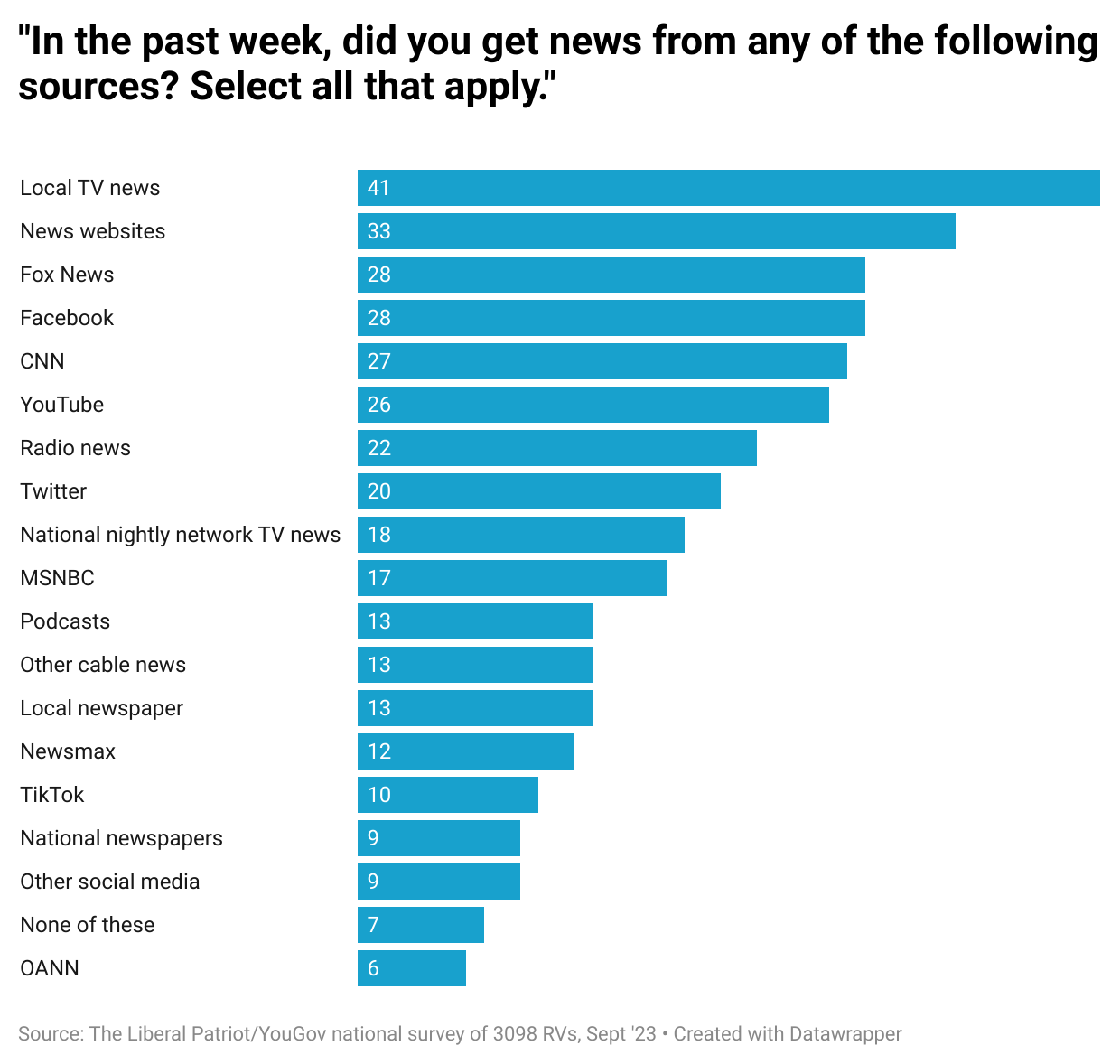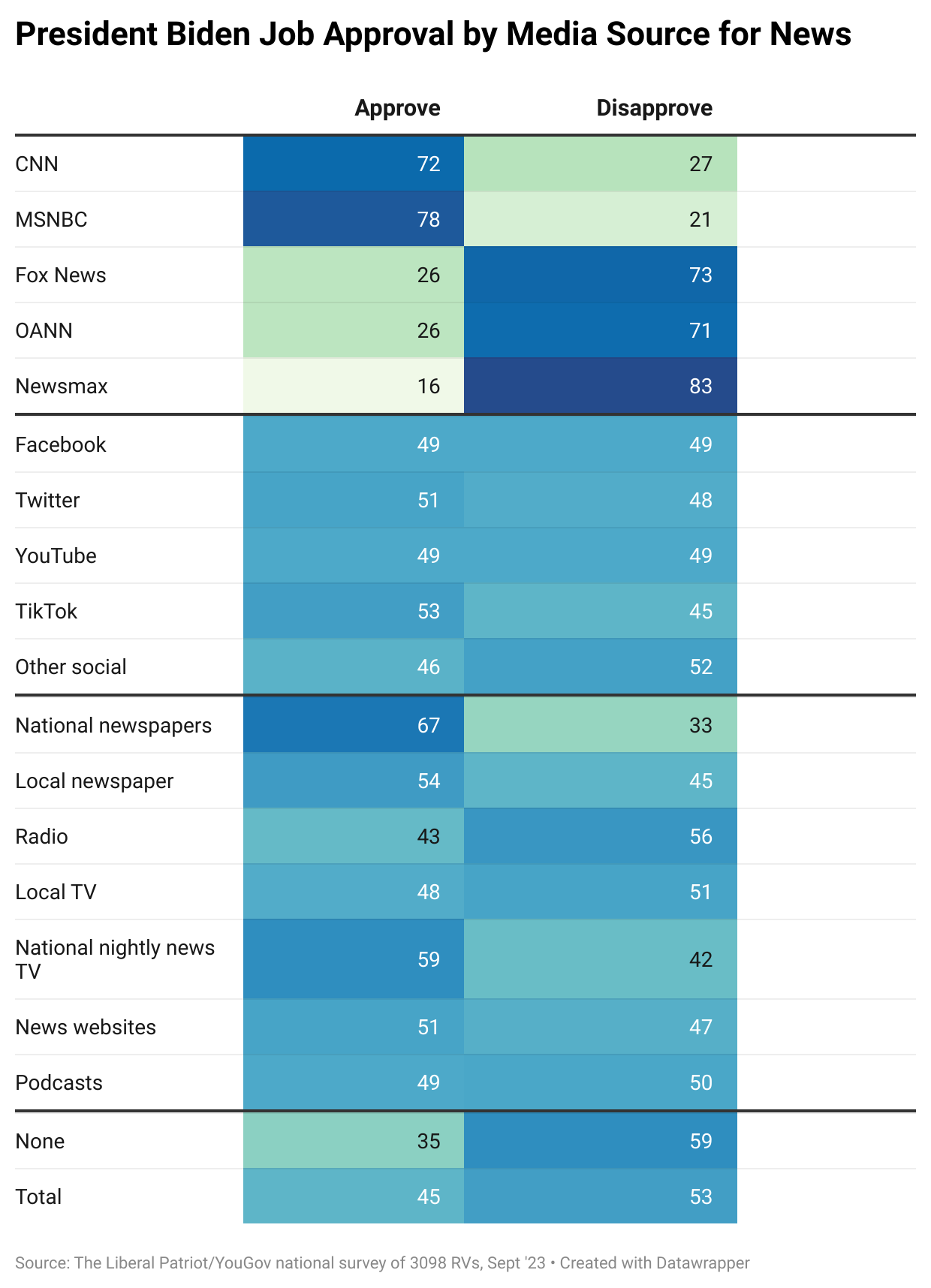The following article by John Halpin, president and executive editor of The Liberal Patriot. is cross-posted from The Liberal Patriot:
People often finger social media as the primary culprit in America’s increasingly bitter and divided politics. As the argument goes, corporate tech algorithms and consumer choices are forcing people into closed-looped information circuits full of misinformation, political self-righteousness, and acrimony toward others.
If you happen to spend any time on these social media platforms, you might agree with this assessment. However, the empirical question remains: Are the users of social media any more partisan or ideological than consumers of other types of media?
Looking at data from the recent TLP/YouGov polling of 3098 registered voters conducted in September 2023, the answer is not as simple as conventional wisdom dictates. It turns out, consumers of traditional media—mainly cable news, network television, radio, and national newspapers—exhibit far greater partisan imbalances than do consumers of the biggest social media platforms.
For context, the survey asked respondents, “In the past week, did you get any news from any of the following sources?” and allowed people to make multiple selections.
As the chart below shows, local television remains the most used media source for news information chosen by 41 percent of voters overall. News websites and apps come in second at 33 percent followed by a cluster of different sources including Fox News (28 percent), Facebook (28 percent), CNN (27 percent), and YouTube (26 percent). Notably, national print newspapers were selected by only 9 percent of voters—almost equal to those Americans getting news from the social media video platform, TikTok, at 10 percent. Seven percent of voters overall report not getting news from any of these sources.

Looking at the crosstabs on media usage, the overlap in news consumption is interesting. For example, 54 percent of those who tune into CNN also get news from local television, and 40 percent get news from Facebook. Likewise, 53 percent of those who tune into Fox get news from local television, and 37 percent get news from Facebook. On the social media side, 52 percent of TikTok news consumers also turn to CNN for news, 54 percent watch YouTube, and 59 percent get news on Facebook.
To gauge the partisan leanings of different consumers, I examined the breakdown of media consumers on President Biden’s job approval, which stood at 45 percent approve and 53 percent disapprove among all voters in September. (Job approval and disapproval seems like a more representative measure of political beliefs than the national horserace at this stage, but the patterns are broadly matched in terms of Biden or Trump support.)
As the table below highlights, legacy media users emerge as the most skewed American consumers of media in terms of their approval or disapproval of President Biden—particularly cable news viewers.

For example, among those who get news from CNN and MSNBC, Biden’s job approval is an impressive 72 and 78 percent, respectively—more than 25 points higher than his approval ratings nationally. Conversely, only one quarter or less of those who get their news from Fox, One America News Network, and Newsmax approve of the job Biden is going as president, around 20 points lower than the national average. Consumers of national newspapers and national network news also exhibit much higher approval of President Biden than voters nationally, and when compared to consumers of local newspapers or local television. On the flip side, radio news consumers exhibit higher than average disapproval of Biden.
In contrast, users of an array of social media platforms—including Facebook, Twitter, YouTube, TikTok, and other social media (including LinkedIn and Instagram) appear more evenly split in their evaluations of the president. Among voters who get news from either Facebook or YouTube, an equal 49 percent approve and disapprove of Biden. And although both Twitter and TikTok users overall emerge slightly more pro-Biden than the national average, their approval or disapproval is much less pronounced than that among cable news viewers.
If analysts are looking for the information roots of America’s most intense political polarization, they might want to examine the consumer bases and news content of legacy media sources as much as they scrutinize social media platforms.
The viewers of different cable news channels, and readers of national newspapers or listeners of radio, constitute vastly different (and more one-sided) partisan worlds than most people on social media platforms with a cacophony of voices and partisan inclinations.
Social media often gets dinged for partisan self-selection and ideological reinforcement, which certainly goes on to some extent, but these data show that the sharpest partisans splits are more prominently found among consumers of traditional cable, print, network news, and radio sources.



